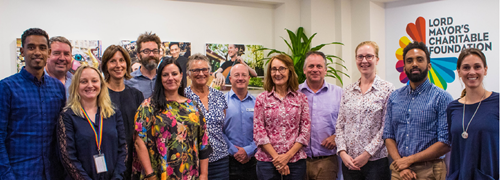There has been a lot of conversation about donations and charities as Australians, and our friends overseas, respond to the bushfire disaster that we are experiencing.
Having just been honoured for my service to the community through charitable organisations, I thought I might write my first blog for 2020 about charitable organisations’ role in our Australian community. My comments are framed from my perspective as CEO of Australia’s largest community foundation, as a lawyer with many years experience in the charitable sector, and as person who sees charities as a force for social and environmental innovation in Australia.
We are very fortunate in Australia to have the health safety net of Medicare but there is another unseen safety net that underpins our community. These are the 56,000 large, medium and small charities that are set up by passionate people for a range of public purposes that benefit the community. Charities enable us to grow knowledge, respond to a wide range of community needs and stand ready when communities face disasters and other challenges. Philanthropic foundations support charities to meet community needs and to test new ideas and find solutions to tough problems – such as climate change and homelessness.
Charities do not operate in a vacuum. They are closely regulated by the Australian Charities and Not for profits Commission (ACNC), the Australian Tax Office (ATO) and state fundraising regulations because of the tax benefits they enjoy. Not all charities may provide tax deductible receipts for donations – this is known as Deductible Gift Recipient endorsement. Charities operate within legislation which ensures they serve their particular charitable purpose or purposes, and that donated funds for which tax deductions have been provided flow to eligible people or organisations where they are needed. Eligibility will depend on whether the charity’s ability to provide tax deductible receipts is because it is endorsed as a Public Benevolent Institution, a Public Ancillary Fund or under another DGR category.
This regulatory system protects against misuse of donated funds and maintains trust and integrity within the charitable sector. While there has been some commentary about the need for speed in distributing donations, charities will all be aiming to distribute donations efficiently, thoughtfully and based on the requirements of charity law.
Charities are an important part of Australia’s unpaid and paid productivity – they all work towards social, educational, cultural, environmental and other community benefit purposes that are defined as charitable activity under the Charities Act 2013 (C’th). Charities contribute around 8.5 per cent of GDP and 16.6 per cent of Australian employment. In addition, around three million people volunteer their time and talents to charities (Deloitte, 2017).
Australia is better for having its strong charitable sector. The charitable sector interacts with government and business but it is independent. It can take a long-term view and it can respond to both entrenched issues and emerging community and environmental challenges as they arise.
The foundation sector is part of the charitable sector. Our key roles are to provide funding for capacity building (including at times ongoing support) and to enable charities to develop innovative responses to tough challenges. Collaboration is an increasing hallmark of our sector.
When philanthropy thinks about disaster relief, we think across a time frame – from immediate relief, short-term recovery (up to six months), longer term recovery (even up to ten years) and disaster preparedness. An example of disaster preparedness is the work we at Lord Mayor’s Charitable Foundation have been doing via the Hot Spots Initiative, which is piloting an approach to building community resilience to reduce the health and social impact of heatwaves in three communities in Melbourne. These communities are lower on socio economic indicators but also highly vulnerable on the Monash Heat Vulnerability Index. Putting knowledge and networks in place within vulnerable communities before disasters occur is critical work.

Hot Spots partners gathered together to discuss recent results from their community resilience projects. As charities work hard to support people affected by the bushfires right now, most are also thinking about the longer term. Many are working on community resilience. Others are working on biodiversity conservation or on climate change mitigation. We should support and trust our charities. They are critical to Australia’s wellbeing and our ability to respond to disasters such as the bushfire crisis.
Dr Catherine Brown OAM
Chief Executive Officer